Street view of the former Martin's Phillips 66 Station in Amarillo Texas
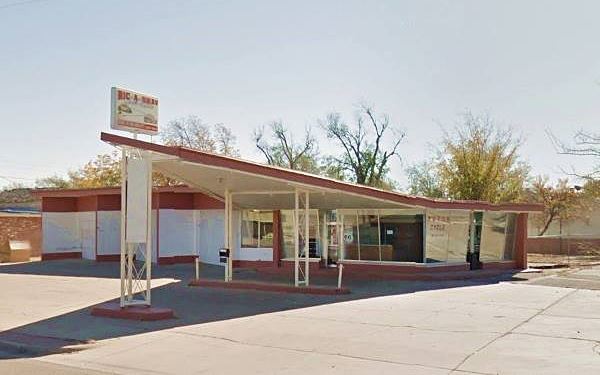
Click on image for Street View
About Texas
Facts, Trivia and useful information
Area: 268,581 sq. mi. (696.241 km2). Population: 26,448,193 (2013 est.).
Width: 773 mi. (1.244 km). Length 790 mi. (1.270 km)
Time zone (along U.S. 66 alignment): Central (CST): UTC minus 6 hours. Summer (DST) CDT (UTC-5).
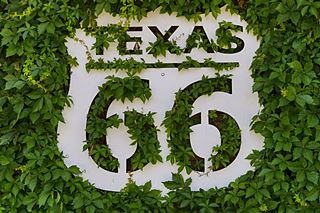
Texas Route 66 Shield. Highsmith, Carol M.
- Nickname: "The Lone Star State", which commemorates its independence war with Mexico and its existence as an independent republic. The "Lone Star" appears on its flag and state seal.
- Motto: Friendship
- State Song: "Texas, Our Texas"
- Capital: Austin
- Highest point: Guadalupe Peak, 8,751 ft. (2.667 m)
- Second most populous state after California.
- Second largest state in the U.S., after Alaska.
- Admitted as the 28th state of the Union on December 29, 1845
- November 22, 1963: President John F. Kennedy was assassinated in Dallas, TX.
- Lyndon B. Johnson, Texan was the 36th president of the United States.
- Route 66 length in Texas is 189 miles (304 km), the second shortest after Kansas.
The Name: Texas
Texas was used by the Spaniards in the 1700s to name the local Caddo natives and their territory.
They adopted a local word, "táysha", from the language of the Hasinai, Caddo, which meant "friends", "allies".
In Spanish, the "X" was pronounced like the English "sh" until 1815 when the Real Academia Española (Royal Spanish Academy) defined that "X" would be used for words of Latin origin and pronounced "ks", the words formerly written with an "X" would now use a "J" (which sounds similar to an English "H"). Other examples of "X" for "J" usage in Spanish are: Xavier (Javier), Mexico (Mejico), Ximena (Jimena), Xalisco (Jalisco).
The History of Texas
Texas has been inhabited for at least 10,000 years.
During historic times, several Native American groups peopled Texas: from the Caddo, Apache, Comanche, Choctaw, Hasinai, Kiowa to the Jumano, Tonkawa and Wichita, among others. They were mainly hunter-gatherer cultures. Nowadays they represent only 0.5% of Texas' population.
Spain extended its rule over Mexico in 1520 and expanded north into what is now into the Southwestern U.S.
Spanish explorer Francisco de Coronado surveyed the area searching for "Eldorado" and reported the local buffalo hunting natives. The mythical city of "Cibola" was located in Texas.
The French encroached on the Spanish domains when René de La Salle founded Fort Saint Louis in 1685 at Matagorda Bay; but it only survived for four years.
It was then that the Spaniards reasserted their rights and founded missions in the region that they named "Nuevo Reino de Filipinas" (New Kingdom of Philippines -after their king, Phillip or Felipe). However the more popular name of Texas prevailed.
In 1803, the U.S. government purchased Louisiana from France and claimed that Texas was part of that territory. Spain and the U.S. settled the issue with an agreement in 1819.
In 1821, Mexico gained its independence from Spain, and Texas formed part of the new republic. Mexico granted lands to colonizers and many Americans seized the opportunity, settling in Texas. However they often violated Mexican law, such as the law which prohibited slavery so Mexico imposed migratory restrictions and new taxes (1830).
View of Glenrio

This led to revolt (1832) and demands for statehood within the Mexican Federation. Unrest persisted and erupted as the Texas Revolution (1835) and a provisional government. War ensued and Mexican President Antonio de Santa Ana led an army to quell the revolt.
He defeated the rebels at El Alamo but the Texans declared their independence (March 3, 1836), forming the Republic of Texas. War ended when Sam Houston defeated and captured Santa Ana at the battle of San Jacinto.
After Mexico attacked the Republic in 1842 it became clear that they needed additional resources. Houston's party promoted joining the U.S. Which took place in 1845, when the U.S. annexed Texas, which became the 28th state of the Union on December 29, 1845.
Mexico opposed to the Texas border claimed by the U.S. and this led to a breakage of diplomatic relations and the Mexican-American War (1846 - 48). The war concluded with Mexico's defeat and the cession of what are now the states of Southwestern US (California, Utah, Nevada, Arizona, New Mexico, Texas and parts of Oklahoma, Colorado, Kansas and Wyoming).
Statehood brought an increase in slavery: African Americans worked as slaves in the cotton fields of eastern Texas. And after the election of Abraham Lincoln, Texas joined the pro-slavery secessionist states of the South, and became part of the Confederate States of America in 1861 and fought on its side during the American Civil War.
Route 66 entering Adrian, Texas

John Phelan
The last battle of the Civil War was fought at Palmito Ranch, close to Brownsville, Texas at Palmito Ranch. War ended with the victory of the Union. Slavery ended with the Emancipation Proclamation and in 1866, civilian government was restored in the State.
During the 20th century, oil was discovered (1901) and an Oil Boom boosted the state's economy, which was until then mostly based on farming and cattle raising.
The drought years of the Dust Bowl and the Great Depression impacted on employment and was only reverted by Federal funds during New Deal Programs (such as the one that helped pave U.S. 66) and later during World War II investment in military facilities, POW Camps (like the one at McLean on Route 66).
During the Post War years, industry and services sectors grew and became an important part of Texas economy.
Geography
Despite popular belief, less than 10% of Texas is desert. Due to its size, it has several regions, and Route 66 crosses its Great Plains region.
Texas is located on a geologically stable region and there are no volcanoes in Texas. Earthquake risk is low.
View of Palo Duro Canyon
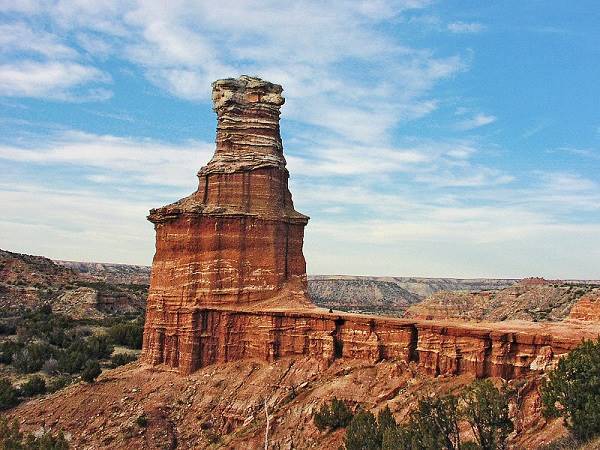
Texas' Climate
The size of Texas means that it spans different climate zones. The Panhandle region (where U.S. 66 crosses the state) is located in the north of Texas and winters tend to be colder. Rainfall increases from west to east and is highest on the coast of the Gulf of Mexico.
Snow is frequent in the Panhandle, where it snows several times during winter, but scarce in the rest of the state. Summers are quite hot and temperature increases with a southwards cline.
Thunderstorms take place frequently in northern and eastern Texas. Tornados strike often; Texas is part of Tornado Alley, and experiences an average of 139 tornados yearly. The Panhandle region (and the alignment of U.S. 66) has a high frequency of tornados too. (Full information on Tornadoes.)
Hurricanes hit the Gulf region; the worst natural disaster in U.S. history took place in Galveston Texas in 1900: the Galveston Hurricane killed between 8,000 and 12,000 people.
Texas Cities
Amarillo is the largest city along Route 66 in Texas, but the state has three very large cities: Houston with 2.2 Million inhabitants, San Antonio with 1.4 Million and Dallas with 1.26 Million; they are ranked among the ten most populous cities in America.
Around 144,000 people live along Route 66's corridor through Texas.
Culture
Texas culture arose from a mixture of Mexican - Spanish and Anglo influences. Southern U.S. (Dixie), Western and 19th century immigrant traditions have also blended and shaped Texas culture.
Tacos, Burritos are typical in Texas cuisine. The cowboy and country western music are also typically associated with Texas.
"Texas-sized"
Everything is bigger in Texas. The size of the state, its variety and distinctness has led to an expression symbolizing something that is bigger than other similar objects: "Texas Sized".
Where to Stay in Texas
Accommodation in Texas
The towns along Route 66 offer different lodging options. Check out hotels and motels in the main towns:
>> Book your Hotel in Texas
Check out RV and Motorhome Parks & Campgrounds in Texas.
Booking.comMap of Route 66 through Texas
Interactive Route 66 map in TX
See our Texas Route 66 map, with the location of each town, and links on the map that give full details on attractions, sights, Route 66 icons and more.
Route 66 itinerary across Texas

Detailed description of the alignment of U.S. 66 through Texas, from east to West:
Attractions & Sights
Things to Do and See along Route 66 in Texas
You can drive along almost the full length of the original Route 66 alignment through the Texas Panhandle. Small towns whose Main Streets once flourished with tourists and motorists travelling along the Mother Road now languish next to Interstate 40, full of vintage motels, garages, service stations and memories of the golden days of U.S. 66. Below is a list of some of these landmarks, attractions and historical sites:

Billy Hathorn
Towns located on Route 66
Texas towns, from East to West
»CLICK on images below for full details
CONOCO Tower Station
Listed in the National Register of Historic Places
In Shamrock
Historic CONOCO Tower Station, Shamrock Texas

Clinton Steeds
The "Conoco Tower Station" is an iconic and unique Art Deco landmark crowned by a 100 foot tower located six blocks from Shamrock's commercial center.
James Tindall and R. C. Lewis built it in 1936. It was the first commercial business to be built on U.S. Highway 66 in Shamrock and was quickly nicknamed the «Tower Station». It comprised a Conoco gas station, a diner named "U-Drop Inn"
It is one of the tallest structures in the center of Shamrock and the neon-lighted tower lured in the customers. The building's facade is decorated with green and gold terracotta tiles and a distinctively Art Deco relief motif on canopies and tower bases.
Phillips 66 Service Station, McLean
In McLean

Phillips 66 service station at McLean, TX. David Spigolon
Route 66 reached McLean in 1927 and shortly after Phillips Petroleum chose the town as the location of its first gasoline station in Texas, which stands to this day. The building is surprisingly small for modern travelers, it was built in Tudor Revival style (which imitated medieval English cottages with simple lines, steep pitched roofs, tall windows, brickwork walls and high chimneys). The service station closed in 1977 but has been restored to its original condition.
The gas stations were designed to blend in with the local neighborhoods, which were residential and that was the origin of the "cottage" look.
The company developed a high-octane gasoline in 1927 and ran a test drive along the brand new U.S. Highway 66. The car reached a cruising speed of 66 mph so inevitably the fuel was named Phillips 66®. The highway's shield shaped road sign inspired the company logo.
U.S. Route 66-Sixth Street Historic District
In Amarillo

Cazzell Buildings. A. Whittall
Listed in the National Register of Historic Places
The Historic Route 66 - 6th Street District spans 13 blocks along Sixth Street in the San Jacinto Heights district between Georgia and Forrest Avenues. It has several vintage service stations and buildings in different architectural styles from the 1920s to 1940s including stores, shops and a motel. Time travel to the classic Route 66 days.
Its current asphalt paving dates back to 1942 when the street was widened, blending 1940s features into buildings of the 1920s.
The Sixth Street became a part of town catering to the 1920s travelers: a City Tourist Camp accommodated them; "auto campers" slept by their cars in the open, there were 12 service stations by the end of the 1930s. Service Stations were now designed to attract customers, with canopies, restrooms and pumps that were set away from the roadside. There were 25 tourist courts along route 66 in Amarillo by 1928.
US Route 66 moved to its newer alignment in 1953 when the four laned Amarillo Blvd. was completed to bypass the congested downtown area. Motels with swimming pools and restaurants soon sprung up along the new route, ending the golden era for the old Sixth St.
The district was added to the National Register of Historic Places in 1994.
Buggy Ranch
In Conway
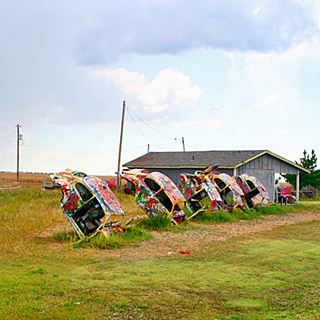
View of Bug Ranch, Conway Texas. Chuck Coker
The Crutchfields have operated a service station and souvenir shop on the south frontage road of I-40 at its crossing with TX 207 in Conway since 1967.
But business took a turn for the worse when a Love's Travel Stop (a truck stop) opened on the other side of I-40: most of the potential customers went there. So the Crutchfields decided to create an attraction on the south side of the Interstate and found inspiration in the Cadillac Ranch (west of Amarillo): they parodied it by burying five Volkswagen Beetles (Bugs) nose down in the ground. Visitors came but business did not improve and the Crutchfields moved on. The visitors paint the cars with spray paint just like they do at the Cadillac Ranch.
Cadillac Ranch
In Bushland next to Amarillo
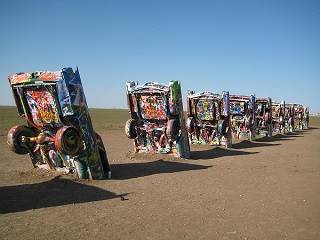
Cadillac Ranch, Amarillo, Texas. Richie Diesterheft
The Cadillac Ranch (also known as the Caddy Ranch), is a public art work, created in 1974 and exhibited in open ranchland which is used for farming and breeding cattle.
It is the creation of a group of artists from San Francisco, known as the Ant Farm, and was sponsored by Texas millionaire Stanley Marsh 3. This "work of art" consists of a group of 10 Cadillac cars buried nose-down in the ground, so that they can show off their tailfins, with an east to west alignment. Each car belongs to a different model, from 1948 to 1963.
Historic Vega Motel
In Vega

Historic Vega Motel (1940s), Vega, Texas
by Ammodramus
Listed in the National Register of Historic Places
A classic hotel of the heyday years of Route 66 in the late 1940s. It began as the Vega Court (not motel) when it was built by Ervin Pancoast in 1947. Those were the boom days of Route 66: the U.S. economy was booming, people were relaxed and enjoying their free time and prosperity after the grim days of the Great Depression and World War II. It was built with two wings, one on the west, the other on the south. It had 12 units. The office and living quarters were located in a small house in the central courtyard.
Air travel and the Interstate highway system (I-40 in Vega was finished in the early 1970s) which bypassed the small towns led to a drop in road travel. The Pancoast sold the motel in 1976.
Midpoint Café
In Adrian

Midpoint Sign, Adrian, Texas. QuesterMark
The Halfway mark
Adrian has the honor of being the Geo-mathematical Center of Route 66: the original U.S. highway 66 ran 1,139 miles east to Chicago and the same distance west to Los Angeles.
This small rural town is the midpoint and halfway point of US 66.
There is a cafe at the site, with a restaurant, souvenir and antique shop.
This cafe bears the record of being the oldest continuously-operating cafe along U.S. Highway 66 between Amarillo, TX and Tucumcari, NM, as well as being the midpoint between Los Angeles and Chicago.
In 1928, two years after the creation of U.S. 66, a very simple brick building went up in Adrian to cater for the travelers: a one-room construction with a compacted earth floor which was known as "Zella's", after Zella Prin, who leased it.

Midpoint Cafe, Adrian, Texas. Peer Lawther
It was enlarged in 1947. Jesse Fincher and Dub Edmunds bought it in 1956 who renamed the place "Jesse's Cafe" and ran it for 20 years together with a service station that was next to it.
Business turned sour in 1969 when I-40 bypassed Adrian and travelers stopped passing through the town; this led to the sale of the Cafe.
Terry and Peggy Creitz acquired it and changed its name to "Peggy's Café". After another change of ownership (when it was renamed again, as "Rachel's"), it was sold to Fran Houser in 1990.
Houser called it the "Adrian Café" and ran it until 2012 when she retired; in 1995 she renamed it "Midpoint Café" to ratify its unique location on the halfway point of US 66./p>
Pixar was inspired by the Midpoint Cafe to create Flo's V8 Café in the animated film Cars (2006).
The characters Flo, Mia and Tia were based on Fran Houser and two of her restaurant's employees, the sisters Christina and Mary Lou Mendez.
The movie's credits acknowledges the café and Fran Houser.
Ranchotel
In Amarillo

Ranchotel. A. Whittall
Listed in the National Register of Historic Places
Built in 1940, it is a "U" shaped building with 16 units linked by alternating garage parking spaces.
It created a Western ranch air with its stucco-covered walls, chimneys, wooden windows & shutters. Gabled roofs with exposed rafter ends and wagon-wheel handrails added to the charm.
They were furnished with rustic beads, tables and chairs; the lamps had cowhide lampshades, the mirrors were horseshoe shaped.
When traffic moved to Amarillo Blvd. in 1953, it became an apartment building (and remains so until today) which was listed in the National Register of Historic Places in 1995.
Accommodation Search box:
Chose your state and book your hotel
Pick your Hotels & Motels by state
Glenrio Historic District, Glenrio, Texas & New Mexico
In Glenrio

Closed Little Juarez Diner & Café in Glenrio, Texas Worldbuilder
Listed in the National Register of Historic Places
The Historic District is defined by Historic Route 66, Glenrio TX and NM.
The Historic District preserves several vintage gasoline filling stations, motels and diners of the period when Route 66 was the main road through the Panhandle region of Texas, between 1926 and 1976.
Glenrio is a ghost town that spans the Texas - New Mexico state line, with derelict buildings. It is located on the Historic alignment of U.S. Route 66, which shortly after entering NM, turns into a gravel surfaced road.
Historic Triangle Motel
In Amarillo
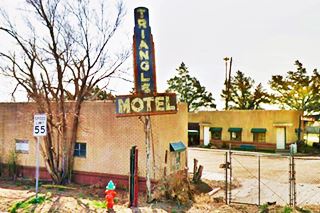
Triangle Motel. A. Whittall
Listed in the National Register of Historic Places in 2010.
Silas Clayton built the Triangle Motel between 1946 and 1952 on a triangular site at the intersection of US 66 and US 60 (E. Amarillo Blvd.) to serve the growing flow of motorists along Route 66
The Historic Motel is on Triangle Dr. and E. Amarillo Blvd., Amarillo TX.
The buildings were built in Streamline Moderne style and remodeled in 1956 replacing the stucco finish with a brick veneer. The rooms were located in two linear buildings that face each other with inset garages between rooms.
The site included a café and service station (Triangle 66), and was hit by a small tornado in the 1950s.
Clayton retired in 1977 and sold the business.
Some sponsored content:
>> Book your Hotel in Rolla


Credits
Banner image: Hackberry General Store, Hackberry, Arizona by Perla Eichenblat.




